Quantitative Precipitation Estimates Using Machine Learning Approaches with Operational Dual-Polarization Radar Data
Abstract
1. Introduction
2. Data
2.1. Training Dataset: 2DVD Data
2.2. Operational MYN S-Band Dual-Polarization Radar Data
3. Methods
3.1. Machine Learning
3.2. Rainfall Estimation
3.2.1. R–Z Relationship
3.2.2. ML-Based Estimation
3.2.3. Validation
3.3. Application to Operational Radar Data
4. Results
4.1. Rainfall Estimation from Simulated Dual-Polarization Variables
4.2. Rainfall Estimation from Operational Radar
5. Conclusions
Author Contributions
Funding
Data Availability Statement
Acknowledgments
Conflicts of Interest
References
- Ryzhkov, A.V.; Zrnić, D.S. Comparison of Dual-Polarization Radar Estimators of Rain. J. Atmos. Ocean. Technol. 1995, 12, 249–256. [Google Scholar] [CrossRef]
- Brandes, E.A.; Zhang, G.; Vivekanandan, J. Experiments in Rainfall Estimation with a Polarimetric Radar in a Subtropical Environment. J. Appl. Meteorol. 2002, 41, 674–685. [Google Scholar] [CrossRef]
- Matrosov, S.Y.; Cifelli, R.; Kennedy, P.C.; Nesbitt, S.W.; Rutledge, S.A.; Bringi, V.N.; Martner, B.E. A comparative study of rainfall retrievals based on specific differential phase shifts at X- and S-band radar frequencies. J. Atmos. Ocean. Technol. 2006, 23, 952–963. [Google Scholar] [CrossRef]
- Bringi, V.N.; Rico-Ramirez, M.A.; Thurai, M. Rainfall Estimation with an Operational Polarimetric C-Band Radar in the United Kingdom: Comparison with a Gauge Network and Error Analysis. J. Hydrometeorol. 2011, 12, 935–954. [Google Scholar] [CrossRef]
- Thompson, E.J.; Rutledge, S.A.; Dolan, B.; Thurai, M.; Chandrasekar, V. Dual-polarization radar rainfall estimation over tropical oceans. J. Appl. Meteorol. Climatol. 2018, 57, 755–775. [Google Scholar] [CrossRef]
- Bringi, V.N.; Chandrasekar, V. Polarimetric Doppler Weather Radar: Principles and Applications; Cambridge University Press: Cambridge, UK, 2001; ISBN 9780521623841. [Google Scholar]
- Zrnić, D.S.; Ryzhkov, A. Advantages of Rain Measurements Using Specific Differential Phase. J. Atmos. Ocean. Technol. 1996, 13, 454–464. [Google Scholar] [CrossRef]
- Friedrich, K.; Germann, U.; Gourley, J.J.; Tabary, P. Effects or radar beam shielding on rainfall estimation for the polarimetric C-band radar. J. Atmos. Ocean. Technol. 2007, 24, 1839–1859. [Google Scholar] [CrossRef]
- Kumjian, M.R. Principles and applications of dual-polarization weather radar. Part II: Warm and cold season applications. J. Oper. Meteorol. 2013, 1, 243–264. [Google Scholar] [CrossRef]
- Marshall, J.S.; Palmer, W.M.K. The distribution of raindrops with size. J. Meteorol. 1948, 5, 165–166. [Google Scholar] [CrossRef]
- Maki, M.; Park, S.G.; Bringi, V.N. Effect of natural variations in rain drop size distributions on rain rate estimators of 3 cm wavelength polarimetric radar. J. Meteorol. Soc. Jpn. 2005, 83, 871–893. [Google Scholar] [CrossRef]
- Lee, G. Sources of errors in rainfall measurements by polarimetric radar: Variability of drop size distributions, observational noise, and variation of relationships between R and polarimetric parameters. J. Atmos. Ocean. Technol. 2006, 23, 1005–1028. [Google Scholar] [CrossRef]
- Sachidananda, M.; Zrnić, D.S. Rain rate estimates from differential polarization measurements. J. Atmos. Ocean. Technol. 1987, 4, 588–598. [Google Scholar] [CrossRef]
- Ryzhkov, A.V.; Giangrande, S.E.; Schuur, T.J. Rainfall Estimation with a Polarimetric Prototype of WSR-88D. J. Appl. Meteorol. 2005, 44, 502–515. [Google Scholar] [CrossRef]
- Cifelli, R.; Chandrasekar, V.; Lim, S.; Kennedy, P.C.; Wang, Y.; Rutledge, S.A. A new dual-polarization radar rainfall algorithm: Application in Colorado precipitation events. J. Atmos. Ocean. Technol. 2011, 28, 352–364. [Google Scholar] [CrossRef]
- Seliga, T.A.; Bringi, V.N.; Al-Khatib, H.H. A Preliminary Study of Comparative Measurements of Rainfall Rate Using the Differential Reflectivity Radar Technique and a Raingage Network. J. Appl. Meteorol. 1981, 20, 1362–1368. [Google Scholar] [CrossRef]
- Ryzhkov, A.V.; Zrnic, D.S. Radar Polarimetry for Weather Observations; Springer Atmospheric Sciences; Springer International Publishing: Berlin/Heidelberg, Germany, 2019; ISBN 9783030050931. [Google Scholar]
- Teschl, R.; Randeu, W.L.; Teschl, F. Improving weather radar estimates of rainfall using feed-forward neural networks. Neural Netw. 2007, 20, 519–527. [Google Scholar] [CrossRef] [PubMed]
- Kühnlein, M.; Appelhans, T.; Thies, B.; Nauss, T. Improving the accuracy of rainfall rates from optical satellite sensors with machine learning—A random forests-based approach applied to MSG SEVIRI. Remote Sens. Environ. 2014, 141, 129–143. [Google Scholar] [CrossRef]
- Ouallouche, F.; Lazri, M.; Ameur, S. Improvement of rainfall estimation from MSG data using Random Forests classification and regression. Atmos. Res. 2018, 211, 62–72. [Google Scholar] [CrossRef]
- Breiman, L.; Friedman, J.; Stone, C.J.; Olshen, R.A. Classification and Regression Trees; Routledge: New York, NY, USA, 1984; ISBN 9780412048418. [Google Scholar]
- Breiman, L. Random forests. Mach. Learn. 2001, 45, 5–32. [Google Scholar] [CrossRef]
- Kusiak, A.; Wei, X.; Verma, A.P.; Roz, E. Modeling and prediction of rainfall using radar reflectivity data: A data-mining approach. IEEE Trans. Geosci. Remote Sens. 2013, 51, 2337–2342. [Google Scholar] [CrossRef]
- Yuan, Q.; Shen, H.; Li, T.; Li, Z.; Li, S.; Jiang, Y.; Xu, H.; Tan, W.; Yang, Q.; Wang, J.; et al. Deep learning in environmental remote sensing: Achievements and challenges. Remote Sens. Environ. 2020, 241, 111716. [Google Scholar] [CrossRef]
- Chiang, Y.M.; Chang, F.J.; Jou, B.J.D.; Lin, P.F. Dynamic ANN for precipitation estimation and forecasting from radar observations. J. Hydrol. 2007, 334, 250–261. [Google Scholar] [CrossRef]
- Chen, H.; Chandrasekar, V.; Cifelli, R. A Deep Learning Approach to Dual-Polarization Radar Rainfall Estimation. In Proceedings of the 2019 URSI Asia-Pacific Radio Science Conference (AP-RASC), New Delhi, India, 9–15 March 2019; pp. 1–2. [Google Scholar]
- Kruger, A.; Krajewski, W.F. Two-Dimensional Video Disdrometer: A Description. J. Atmos. Ocean. Technol. 2002, 19, 602–617. [Google Scholar] [CrossRef]
- Atlas, D.; Srivastava, R.C.; Sekhon, R.S. Doppler radar characteristics of precipitation at vertical incidence. Rev. Geophys. 1973, 11, 1–35. [Google Scholar] [CrossRef]
- Bang, W.; Lee, G.; Ryzhkov, A.; Schuur, T.; Lim, K.-S.S. Comparison of microphysical characteristics between southern Korea and Oklahoma using two-dimensional video disdrometer data. J. Hydrometeorol. 2020, 1–61. [Google Scholar] [CrossRef]
- Thurai, M.; Gatlin, P.; Bringi, V.N.; Petersen, W.; Kennedy, P.; Notaroš, B.; Carey, L. Toward completing the raindrop size spectrum: Case studies involving 2D-video disdrometer, droplet spectrometer, and polarimetric radar measurements. J. Appl. Meteorol. Climatol. 2017, 56, 877–896. [Google Scholar] [CrossRef]
- Mishchenko, M.I.; Travis, L.D.; Mackowski, D.W. T-matrix computations of light scattering by nonspherical particles: A review. J. Quant. Spectrosc. Radiat. Transf. 1996, 55, 535–575. [Google Scholar] [CrossRef]
- Thurai, M.; Huang, G.J.; Bringi, V.N.; Randeu, W.L.; Schönhuber, M. Drop shapes, model comparisons, and calculations of polarimetric radar parameters in rain. J. Atmos. Ocean. Technol. 2007, 24, 1019–1032. [Google Scholar] [CrossRef]
- Lee, G.; Zawadzki, I. Radar calibration by gage, disdrometer, and polarimetry: Theoretical limit caused by the variability of drop size distribution and application to fast scanning operational radar data. J. Hydrol. 2006, 328, 83–97. [Google Scholar] [CrossRef]
- Kwon, S.; Lee, G.; Kim, G. Rainfall Estimation from an Operational S-Band Dual-Polarization Radar: Effect of Radar Calibration. J. Meteorol. Soc. Jpn. Ser. II 2015, 93, 65–79. [Google Scholar] [CrossRef]
- Liaw, A.; Wiener, M. Classification and regression by random forest. R News 2002, 2, 18–22. [Google Scholar]
- Amemiya, Y. Generalization of the TLS approach in the errors-in-variables problem. In Recent Advances in Total Least Squares Techniques and Errors-in-Variables Modeling; Van Huffel, S., Ed.; SIAM: Philadelphia, PA, USA, 1997; pp. 77–86. [Google Scholar]
- Chandrasekar, V.; Bringi, V.N. Error Structure of Multiparameter Radar and Surface Measurements of Rainfall Part I: Differential Reflectivity. J. Atmos. Ocean. Technol. 1988, 5, 783–795. [Google Scholar] [CrossRef]
- Chandrasekar, V.; Bringi, V.N.; Balakrishnan, N.; Zrnić, D.S. Error Structure of Multiparameter Radar and Surface Measurements of Rainfall. Part III: Specific Differential Phase. J. Atmos. Ocean. Technol. 1990, 7, 621–629. [Google Scholar] [CrossRef]
- Chandrasekar, V.; Gorgucci, E.; Scarchilli, G. Optimization of Multiparameter Radar Estimates of Rainfall. J. Appl. Meteorol. 1993, 32, 1288–1293. [Google Scholar] [CrossRef]
- Silvestro, F.; Rebora, N.; Ferraris, L. An algorithm for real-time rainfall rate estimation by using polarimetric radar: RIME. J. Hydrometeorol. 2009, 10, 227–240. [Google Scholar] [CrossRef]
- Nash, J.E.; Sutcliffe, J.V. River flow forecasting through conceptual models part I—A discussion of principles. J. Hydrol. 1970, 10, 282–290. [Google Scholar] [CrossRef]
- Kwon, S.; Jung, S.-H.; Lee, G. Inter-comparison of radar rainfall rate using Constant Altitude Plan Position Indicator and hybrid surface rainfall maps. J. Hydrol. 2015, 531, 234–247. [Google Scholar] [CrossRef]
- Ye, B.Y.; Lee, G.W.; Park, H.M. Identification and removal of non-meteorological echoes in dual-polarization radar data based on a fuzzy logic algorithm. Adv. Atmos. Sci. 2015, 32, 1217–1230. [Google Scholar] [CrossRef]
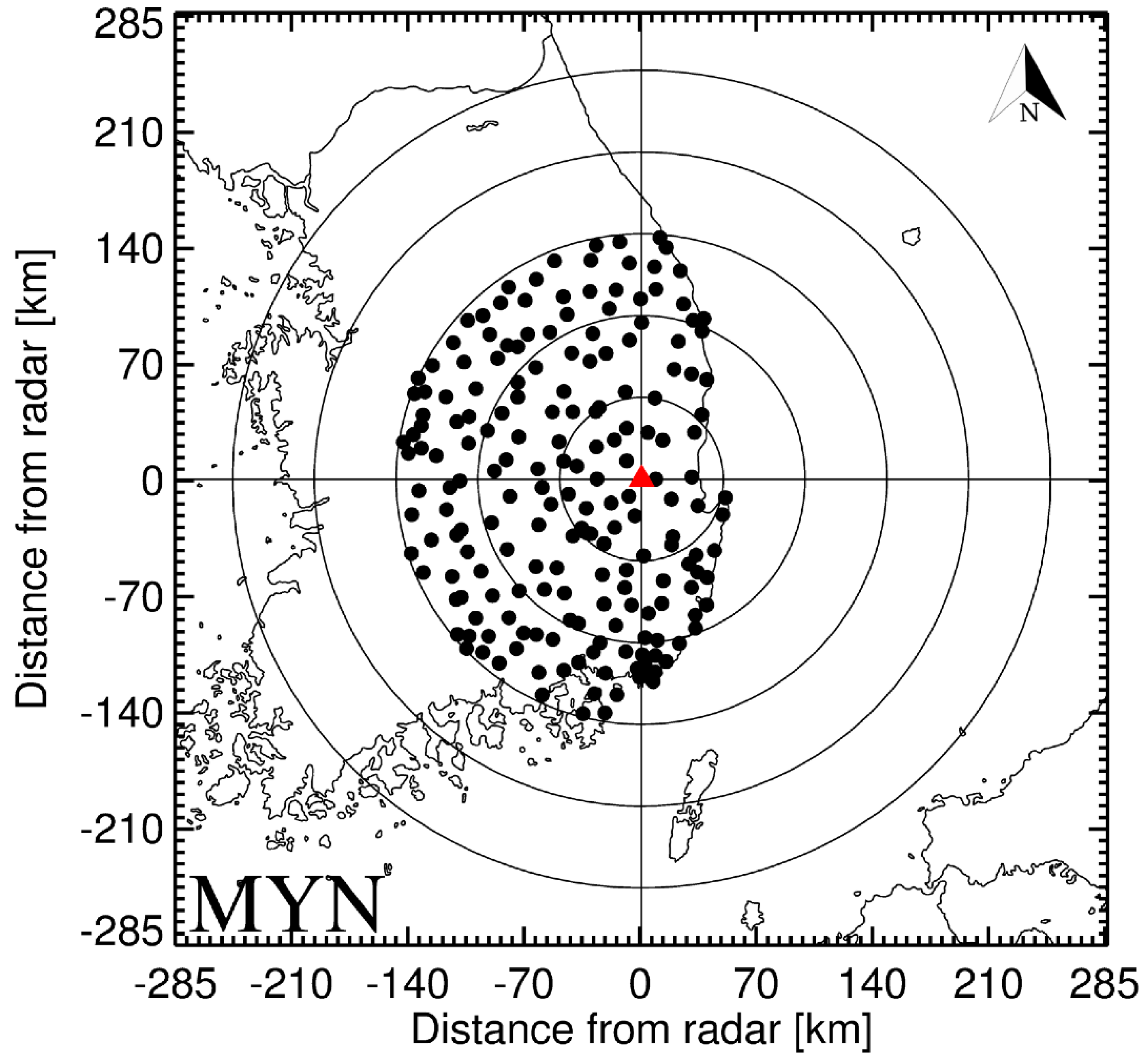
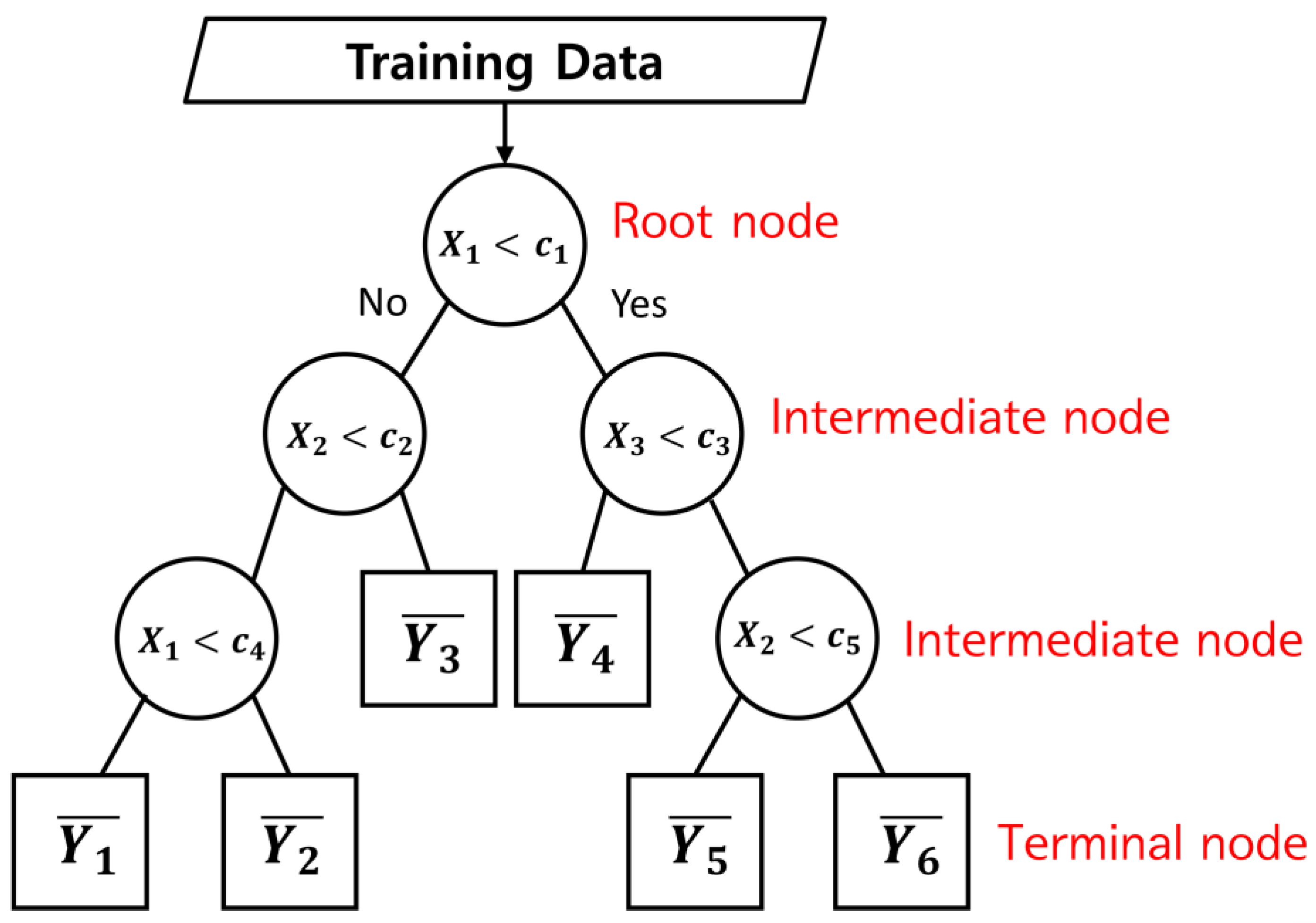

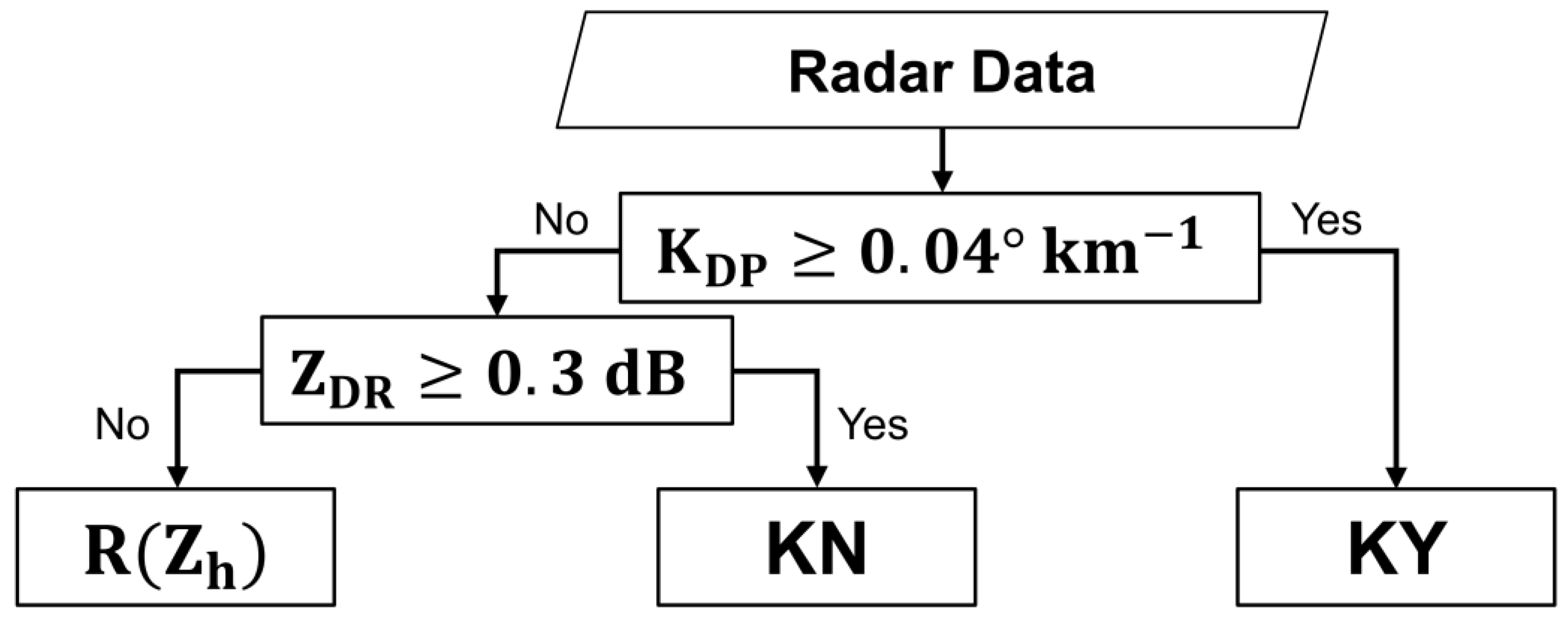
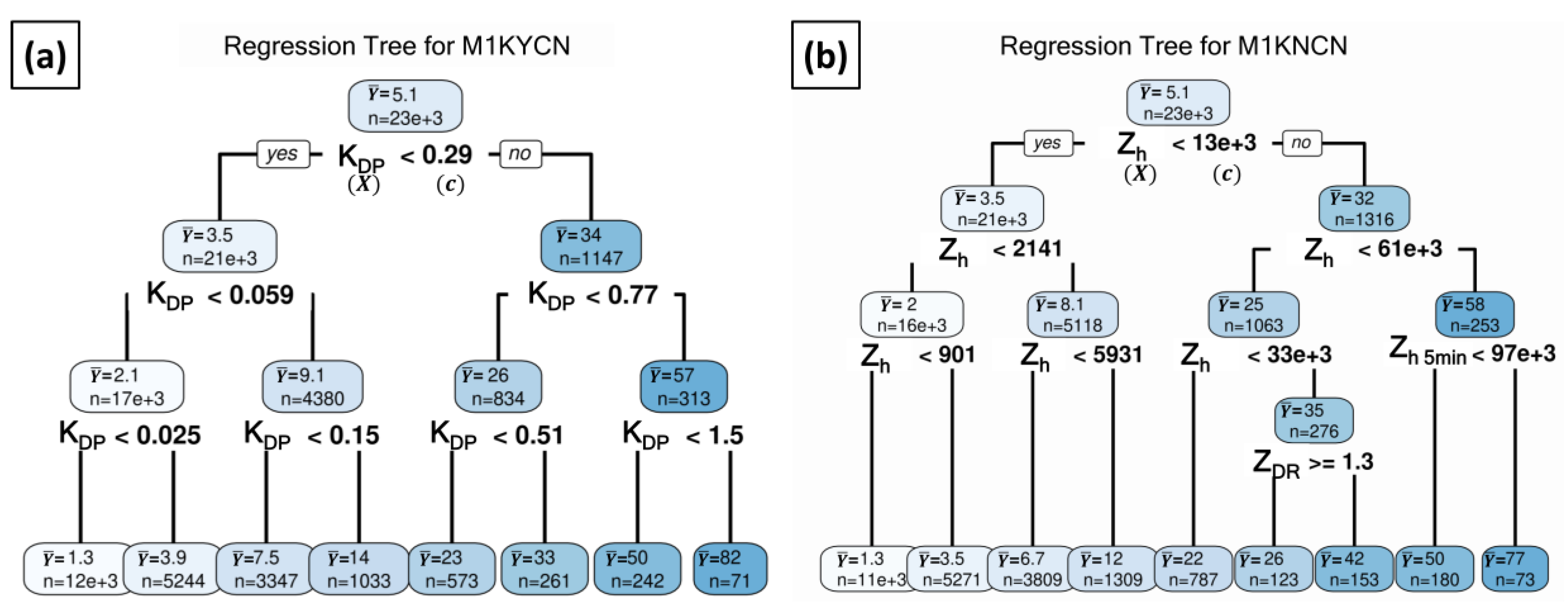

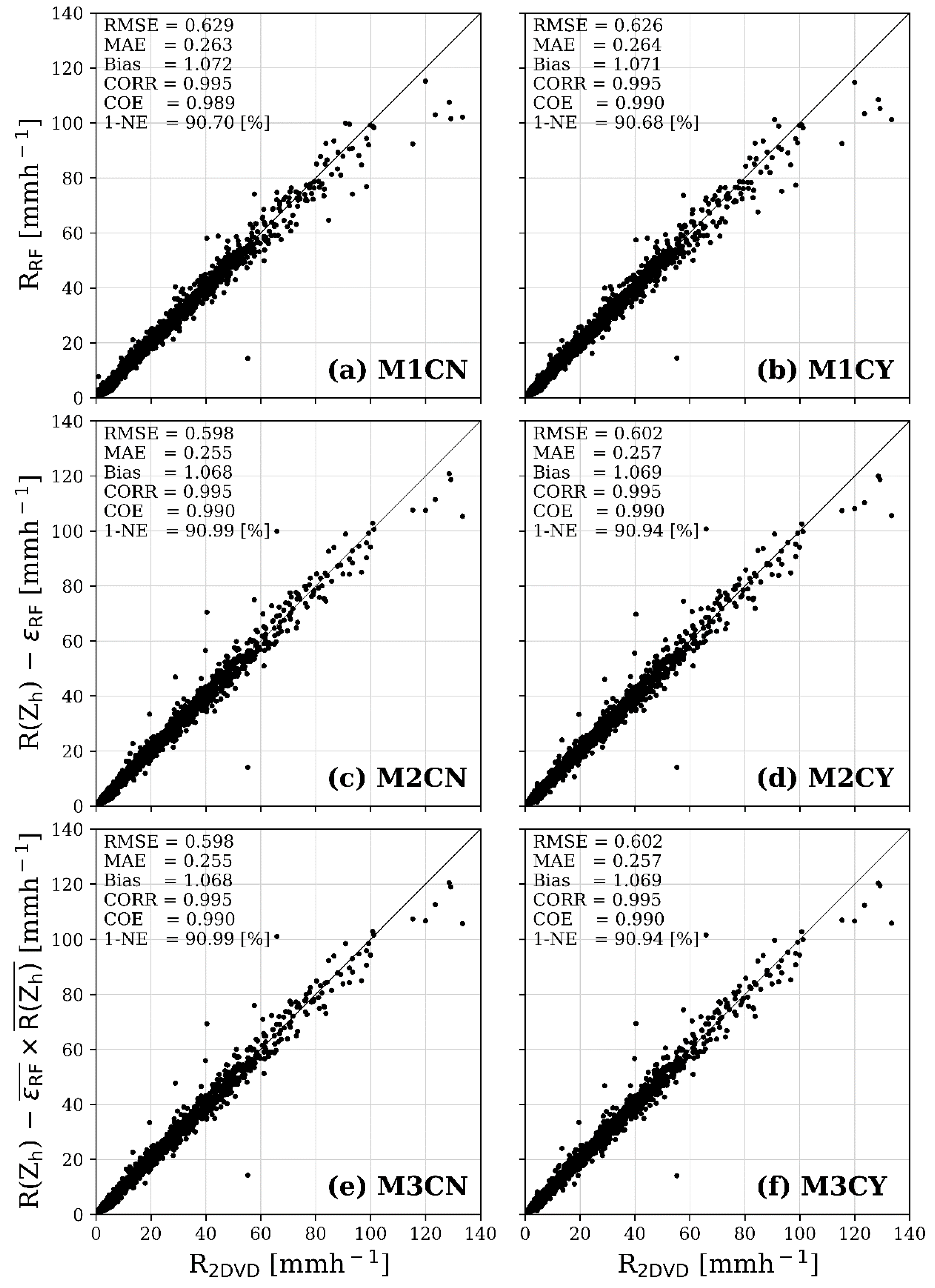
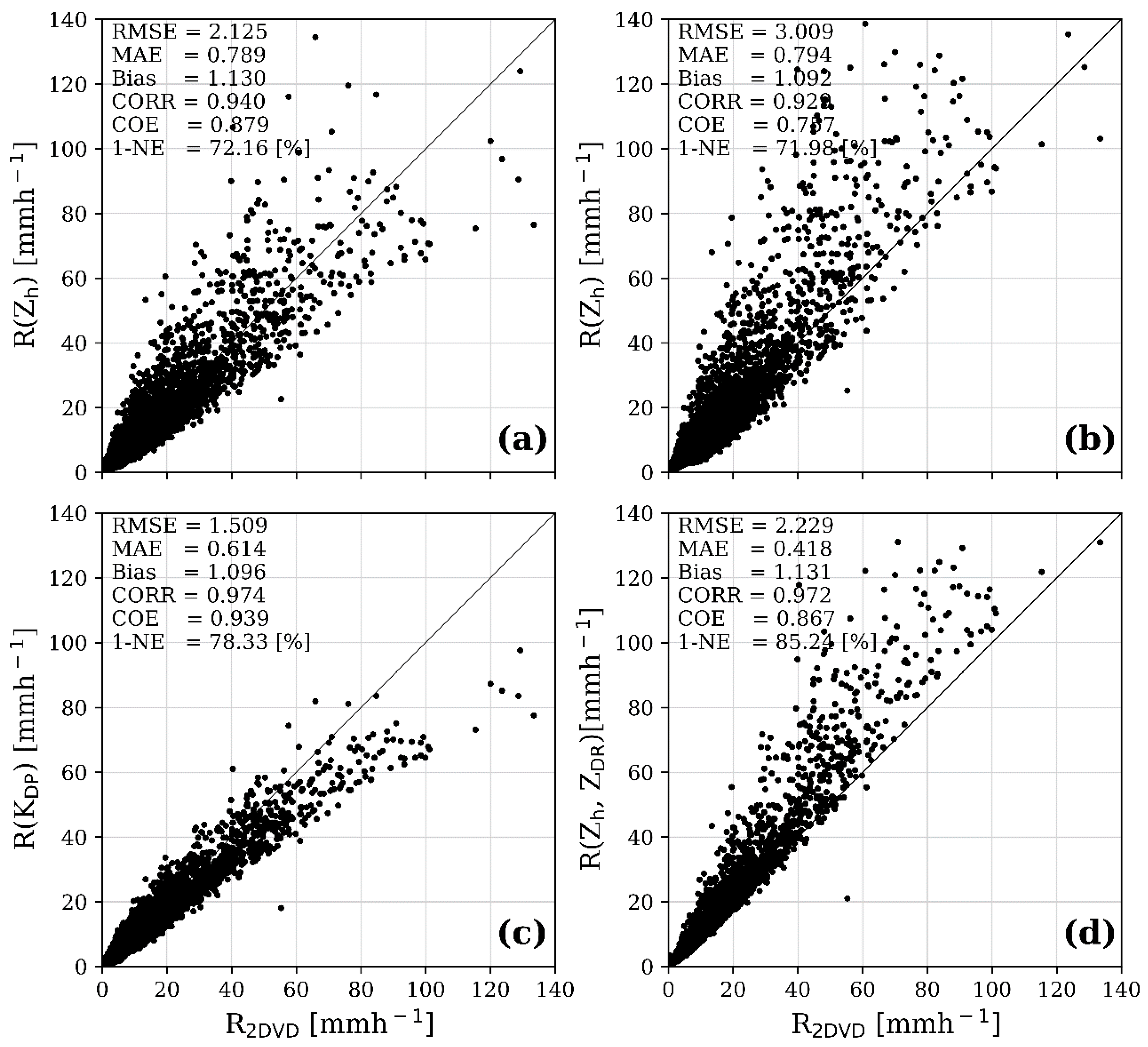
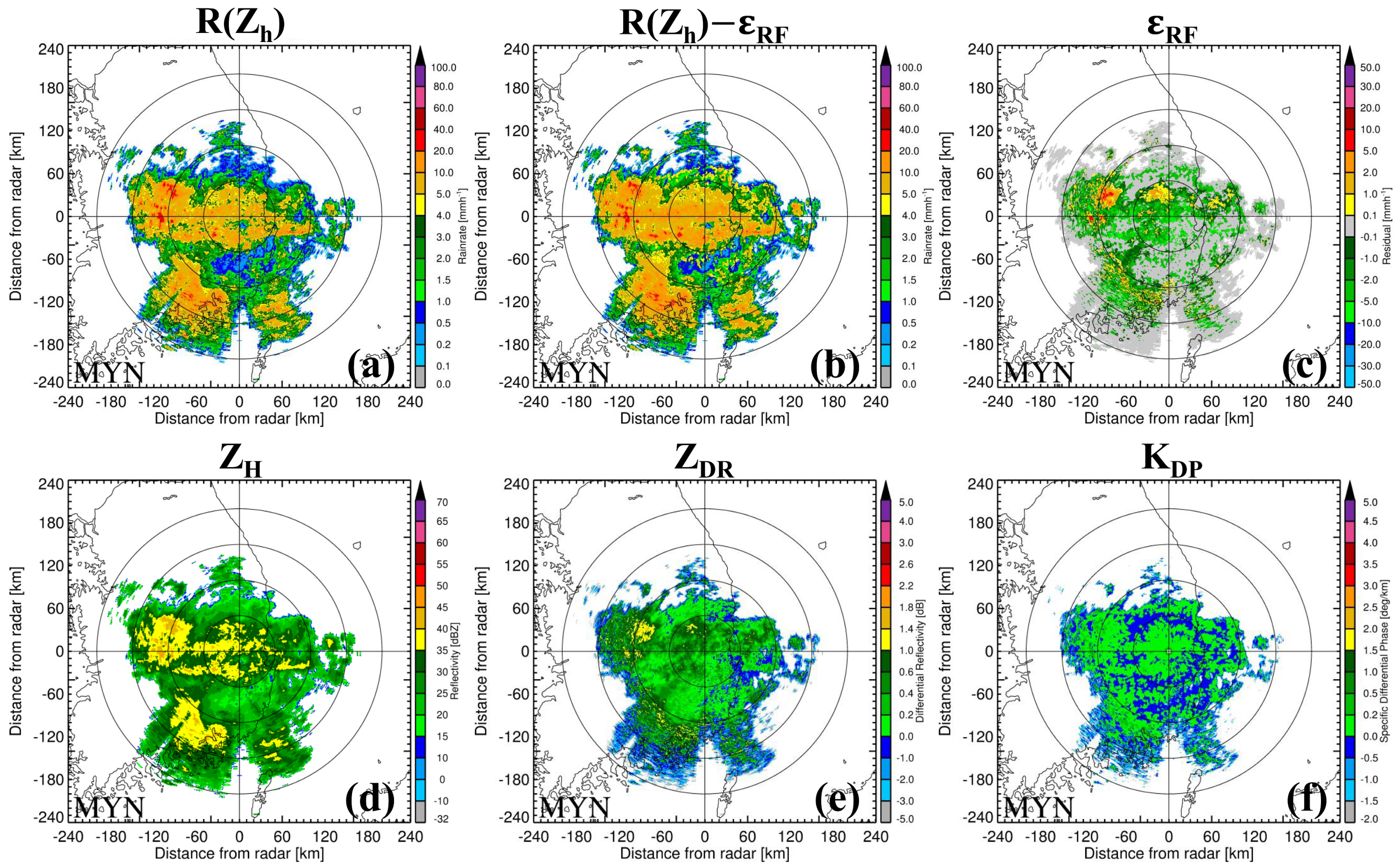

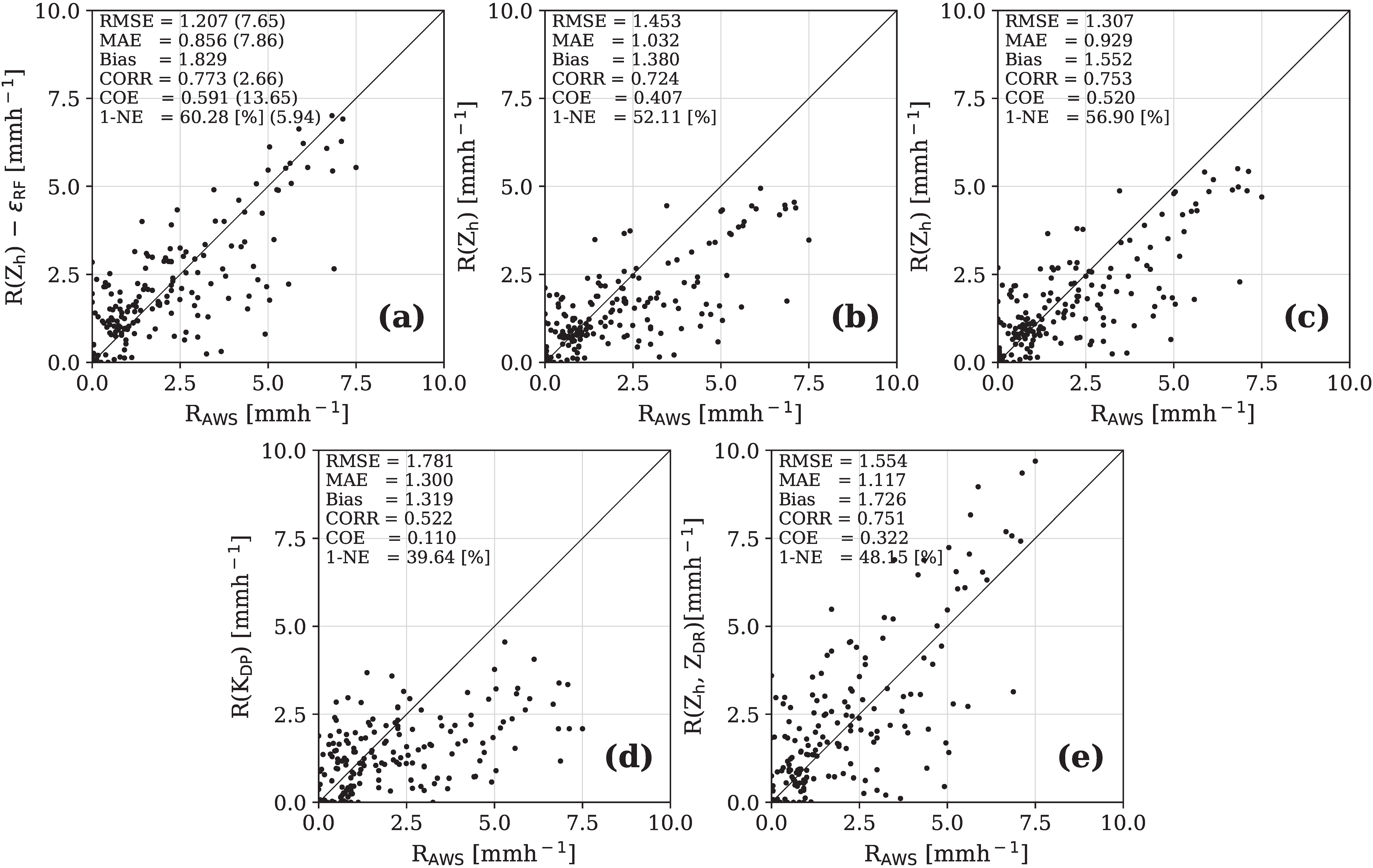
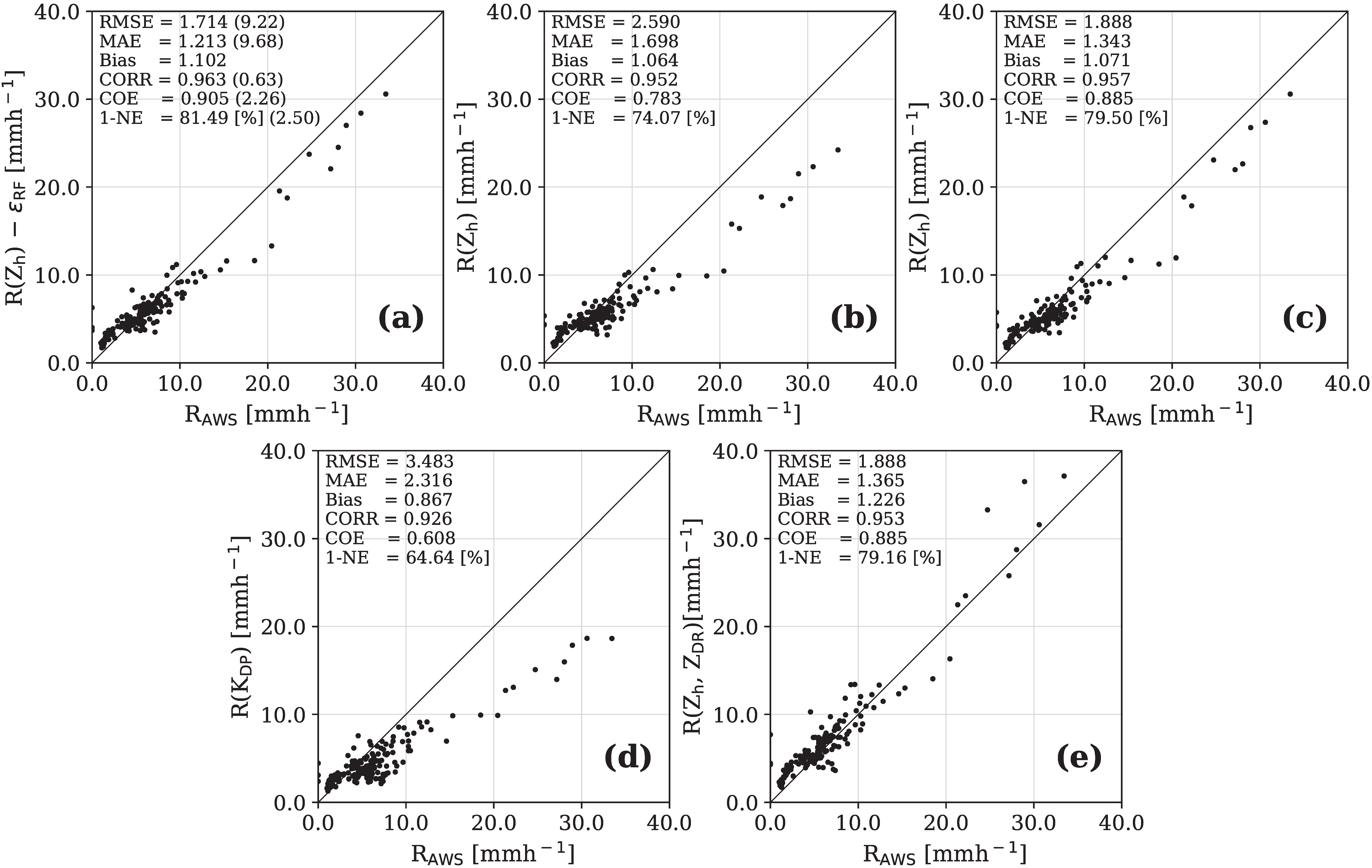

| Area | Period [Year] | Number of 1-min Data | Median of 1-min Rain Rate [mm h−1] | Median of 1-min Reflectivity [dBZ] | Maximum of 1-min Rain Rate [mm h−1] | Maximum of 1-min Reflectivity [dBZ] |
|---|---|---|---|---|---|---|
| Oklahoma, USA (OKL) | 1996–2006 (May to September) | 7944 | 1.78 | 27.72 | 133.39 | 54.88 |
| Daegu (DAE) | 2011–2012 (May to September) | 7516 | 1.36 | 25.09 | 99.24 | 52.50 |
| Boseong (BOS) | 2013–2015, 2018 (May to September) | 12,083 | 0.99 | 22.92 | 93.39 | 53.95 |
| 2018 (October) | 713 | |||||
| Jincheon (JIN) | 2013–2015, 2018 (May to September) | 22,731 | 1.06 | 23.55 | 76.46 | 54.11 |
| 2018 (October) | 315 | |||||
| 2019 (April) | 545 | |||||
| Total | 51,302 | - | ||||
| Characteristics | Values |
|---|---|
| Radar wavelength | 11.01 cm (S-band) |
| Radar elevation angle | 0 |
| Environment temperature | 23 °C |
| Drop shape formula | Taken from Thurai et al. (2007) |
| Parameter | Value |
|---|---|
| Frequency (wavelength) | 2272 MHZ (10 cm, S-band) |
| Location | 36°10′45″N, 128°59′50″E |
| Height | 1136 m |
| Beam width | 0.92 |
| Elevation angles | 0, 0.39°, 0.83°, 2°, 2.88°, 4.06°, 5.67°, 7.88°, and 10.94° |
| Maximum range | 285 km |
| Case No. | Period (LST) | Rain Type |
|---|---|---|
| 1 | 0000–1200 14 August 2017 | Stratiform |
| 2 | 0200–1100 11 September 2017 | Stratiform |
| 3 | 0200–0700 1 July 2018 | Stratiform |
| 4 | 1700 27 August–0600 28 August 2018 | Convective |
| 5 | 1000–1600 3 September 2018 | Convective |
| 6 | 0500–1000 7 September 2018 | Stratiform |
| Class No. | Interval [dBZ] | Number of Observations |
|---|---|---|
| 1 | 599 | |
| 2 | 11,023 | |
| 3 | 9369 | |
| 4 | 1639 |
| Independent Variables | Training Set | Dependent Variables | ||
|---|---|---|---|---|
| Rain rate (R2DVD) (M1) | Residual ( = R(Zh) − R2DVD) (M2) | Normalized residual ( = ) (M3) | ||
| Zh, ZDR, KDP, , Zh 5min, ZDR 5min, KDP 5min (KY) | Not classified training set (CN) | M1KYCN | M2KYCN | M3KYCN |
| Classified by reflectivity interval (CY) | M1KYCY | M2KYCY | M3KYCY | |
| Zh, ZDR, , Zh 5min, ZDR 5min (KN) | Not classified training set (CN) | M1KNCN | M2KNCN | M3KNCN |
| Classified by reflectivity interval (CY) | M1KNCY | M2KNCY | M3KNCY | |
| M1 | M2 | M3 | ||
|---|---|---|---|---|
| KY | Zh | 426,349 | 75,422 | 2734 |
| ZDR | 36,434 | 207,260 | 7153 | |
| KDP | 713,053 | 29,997 | 1019 | |
| 3883 | 22,859 | 641 | ||
| Zh 5min | 147,971 | 19,286 | 635 | |
| ZDR 5min | 36,618 | 87,982 | 2993 | |
| KDP 5min | 311,490 | 11,326 | 385 | |
| KN | Zh | 832,321 | 101,335 | 3347 |
| ZDR | 106,485 | 200,627 | 6948 | |
| 10,998 | 22,430 | 712 | ||
| Zh 5min | 565,867 | 32,965 | 1192 | |
| ZDR 5min | 147,220 | 97,432 | 3308 |
| M1 | M2 | ||||||||
|---|---|---|---|---|---|---|---|---|---|
| KY | Zh | 0.803 | 1351 | 21,850 | 97,115 | 0.080 | 103 | 3064 | 51,941 |
| ZDR | 0.240 | 357 | 10,560 | 24,184 | 0.355 | 484 | 16,522 | 166,202 | |
| KDP | 1.197 | 1861 | 35,962 | 255,737 | 0.112 | 155 | 4303 | 17,446 | |
| 0.041 | 30 | 2625 | 2413 | 0.035 | 62 | 4856 | 26,171 | ||
| Zh 5min | 0.202 | 579 | 7727 | 29,802 | 0.081 | 77 | 1225 | 8406 | |
| ZDR 5min | 0.192 | 265 | 8624 | 15,266 | 0.194 | 257 | 11,103 | 58,468 | |
| KDP 5min | 0.273 | 875 | 15,248 | 88,529 | 0.089 | 130 | 2167 | 6925 | |
| KN | Zh | 1.771 | 2987 | 51,455 | 261,552 | 0.107 | 224 | 62,096 | 62,096 |
| ZDR | 0.363 | 490 | 15,227 | 46,510 | 0.418 | 545 | 153,789 | 153,789 | |
| 0.0616 | 34 | 3188 | 9538 | 0.051 | 55 | 33,457 | 33,457 | ||
| Zh 5min | 0.443 | 1443 | 20,805 | 148,684 | 0.130 | 181 | 14,208 | 14,208 | |
| ZDR 5min | 0.296 | 350 | 11,760 | 43,250 | 0.230 | 261 | 67,743 | 67,743 | |
| Type | Method | RMSE | MAE | Bias | CORR | COE | 1-NE [%] |
|---|---|---|---|---|---|---|---|
| Stratiform | R(Zh) | 1.237 (8.37) | 0.770 (8.66) | 1.294 | 0.956 (0.52) | 0.905 (2.03) | 77.18 (2.88) |
| R(Zh) | 1.676 | 0.843 | 1.190 | 0.936 | 0.825 | 70.79 | |
| Adjusted R(Zh) | 1.350 | 0.985 | 1.210 | 0.951 | 0.887 | 75.02 | |
| R(KDP) | 2.217 | 1.346 | 1.129 | 0.896 | 0.695 | 60.09 | |
| R(Zh, ZDR) | 1.469 | 0.916 | 1.307 | 0.941 | 0.866 | 72.83 | |
| Convective | R(Zh) | 0.612 (3.92) | 0.330 (5.98) | 1.041 | 0.873 (2.22) | 0.731 (3.10) | 55.79 (5.36) |
| R(Zh) | 0.716 | 0.382 | 0.971 | 0.833 | 0.632 | 48.82 | |
| Adjusted R(Zh) | 0.637 | 0.351 | 1.040 | 0.854 | 0.709 | 52.95 | |
| R(KDP) | 1.204 | 0.671 | 1.539 | 0.463 | −0.040 | 10.07 | |
| R(Zh, ZDR) | 0.803 | 0.418 | 0.762 | 0.763 | 0.537 | 40.98 | |
| Total | R(Zh) | 1.039 (8.05) | 0.593 (8.63) | 1.209 | 0.959 (0.52) | 0.912 (1.90) | 75.24 (3.21) |
| R(Zh) | 1.389 | 0.752 | 1.136 | 0.939 | 0.842 | 68.60 | |
| Adjusted R(Zh) | 1.130 | 0.649 | 1.159 | 0.954 | 0.895 | 72.90 | |
| R(KDP) | 1.883 | 1.072 | 1.261 | 0.884 | 0.709 | 55.23 | |
| R(Zh, ZDR) | 1.252 | 0.716 | 1.138 | 0.943 | 0.871 | 70.12 |
Publisher’s Note: MDPI stays neutral with regard to jurisdictional claims in published maps and institutional affiliations. |
© 2021 by the authors. Licensee MDPI, Basel, Switzerland. This article is an open access article distributed under the terms and conditions of the Creative Commons Attribution (CC BY) license (http://creativecommons.org/licenses/by/4.0/).
Share and Cite
Shin, K.; Song, J.J.; Bang, W.; Lee, G. Quantitative Precipitation Estimates Using Machine Learning Approaches with Operational Dual-Polarization Radar Data. Remote Sens. 2021, 13, 694. https://doi.org/10.3390/rs13040694
Shin K, Song JJ, Bang W, Lee G. Quantitative Precipitation Estimates Using Machine Learning Approaches with Operational Dual-Polarization Radar Data. Remote Sensing. 2021; 13(4):694. https://doi.org/10.3390/rs13040694
Chicago/Turabian StyleShin, Kyuhee, Joon Jin Song, Wonbae Bang, and GyuWon Lee. 2021. "Quantitative Precipitation Estimates Using Machine Learning Approaches with Operational Dual-Polarization Radar Data" Remote Sensing 13, no. 4: 694. https://doi.org/10.3390/rs13040694
APA StyleShin, K., Song, J. J., Bang, W., & Lee, G. (2021). Quantitative Precipitation Estimates Using Machine Learning Approaches with Operational Dual-Polarization Radar Data. Remote Sensing, 13(4), 694. https://doi.org/10.3390/rs13040694






